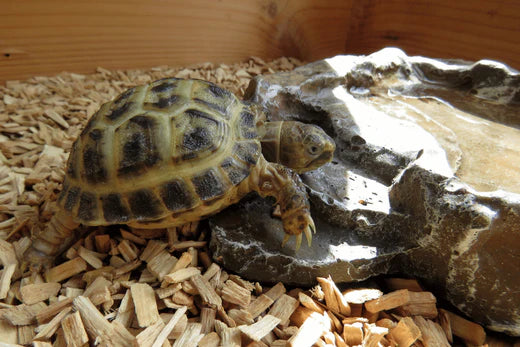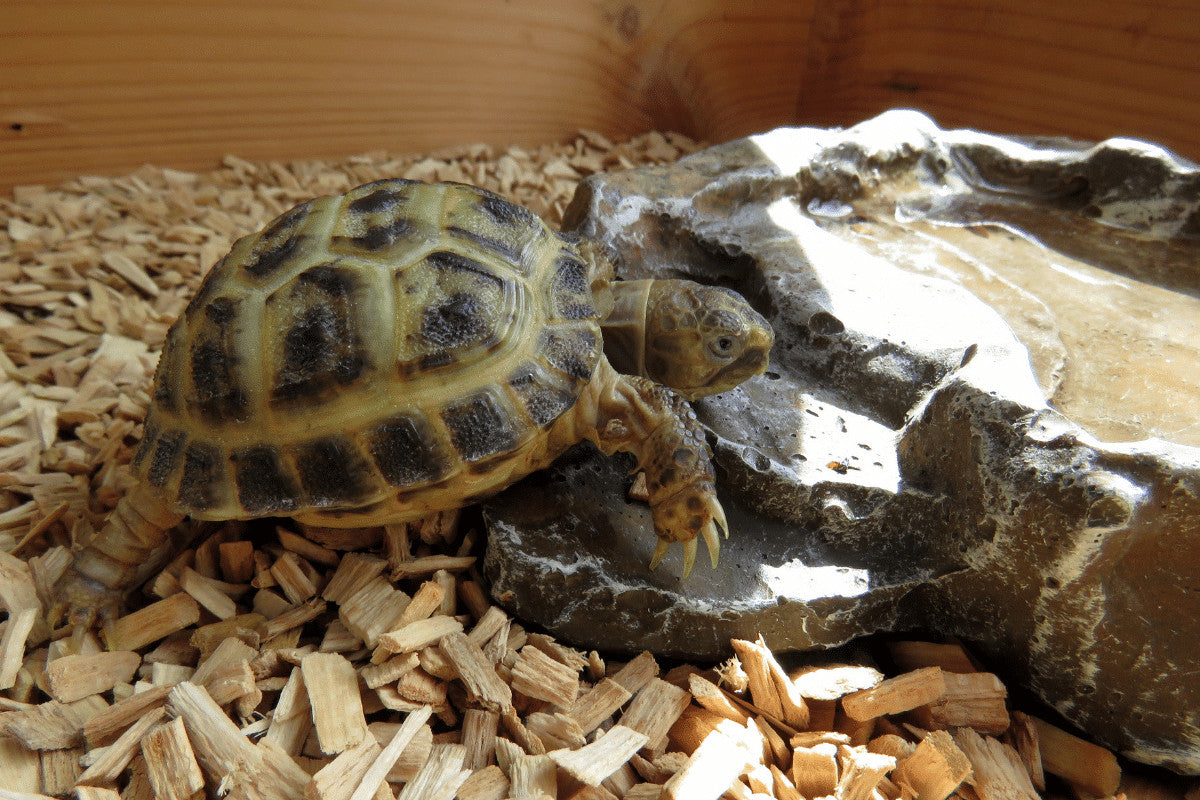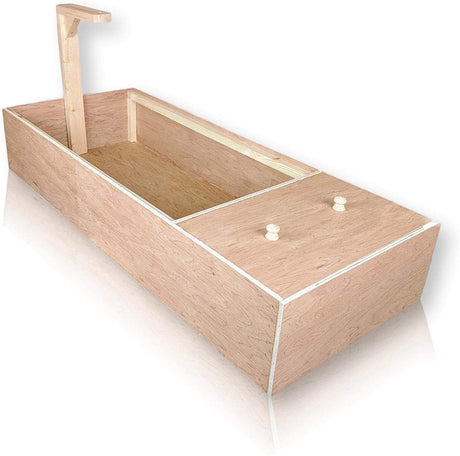Different Types of Substrate
The type of substrate you choose is vital in maintaining your tortoise’s health therefore you should take the time to learn about each one. Each will have their pros and cons, so you will have to decide which works best for your tortoise, your setup, and your lifestyle.
Soil
Soil is one of the most popular substrates for tortoises thanks to how cheap it is and how easy it is to find. Although you can buy normal soil at any garden centre, you need to make sure the soil you provide for your tortoises is sterile and free from fertilizers and pesticides. Sterilised soil is heat-treated to kill off any bacteria that could be harmful to your pet and makes it a safe option for both juvenile tortoises and adults.
If soil alone doesn’t work for you, you can always mix it with one of the other substrates on our list to create a combination that works for you and your tortoise. It is highly versatile and can even hold plants if you want to plant some natural foods in your tortoise enclosure.
This natural substrate is perfect for tortoise species that love to dig such as desert tortoises, and can be piled up and compacted so that small burrows keep their shape and your pet tortoise can fulfil their natural behaviours.

You can easily keep this substrate dry if so preferred by your species of tortoises, or you can mist it to keep it moist for tropical species, however do watch out because if it gets too wet it can become a muddy mess which can be difficult to clean. On the other hand, when it is dry it can be quite dusty which could be irritating if you have allergies.
Finally, soil is a great environment for a range or species so don’t be surprised if you find some creepy crawlies in there.
Key Points:
- Needs to be sterile
- Can get muddy if too wet
- Cheap
- Can hold natural plants
- Can contain bugs
- Is diggable for burrowing species
- Organic soil may smell and contain animal faeces
- Suitable for most species
Wood Chips or Mulch
Wood chippings are another easy-to-come-by substrate, however, be sure that you use a wood that is safe for tortoises - orchid and cypress are some of the most popular wood chips you can use and are safe for reptiles. It can be found in most pet stores and they can even be reused, to some extent; rinse them when they become soiled, then place them in boiling water and then let them dry thoroughly before placing them back into your tortoise’s enclosure. Most tortoise substrates have to be discarded as soon as they become dirty so this could be a game changer for some owners!
They are excellent at absorbing moisture so make a good substrate for tropical species that need a higher humidity, however, due to this, it can also get mouldy which could cause issues for your tortoise if you don’t check it regularly.
Similarly to soil, they can also harbour small insects so be warned if you don’t like that kind of thing. Due to their often chunkier size, these are better for adult tortoises as younger torts may struggle to walk over them.
Finally, if your tortoise ingests them, it can cause some problems to their gastrointestinal tract so keep an eye on if you think they are eating the chips and call your vet if you ever think your tortoise is experiencing any issues.
Key Points
- Reusable
- Choose a safe wood
- Great for tropical species
- Can become mouldy
- May be home to small insects
- Can be dangerous if ingested
- Absorbs odours
- Better for adult tortoises
Grass or Straw Pellets
Grass and straw pellets are quite a controversial option for substrate. Although many amateur tortoise keepers will use them as they are easy to maintain, more seasoned keepers will prefer one of the other options on our list.
Grass pellets do not retain moisture easily and quickly become dusty which could cause respiratory issues for your tortoise. They can become mouldy easily so you should change them completely every two weeks, however, this is recommended for most substrates anyway.
As they are completely natural, they are safe for tortoises to eat however some grass pellets are high in protein therefore you don’t want them to become a staple part of your tortoise’s diet.

Key Points
- Can become mouldy
- Do not retain moisture
- Needs to be changed every two weeks
- Completely natural
- Safe to eat
Hemp
Hemp bedding is essentially very fine wood chips that can, unfortunately, cause serious problems if ingested. It can contain sharp pieces therefore, although it is not toxic to your tortoises, it can cause injury to your tortoise’s internal organs and can even lead to death if it is accidentally swallowed. What’s more, they can even cause splinters if you’re not careful, although tortoise skin is usually thick enough to withstand this kind of injury.
On the other hand, many tortoise keepers will choose hemp bedding thanks to its absorbent and dust free design, and the fact that it is odour free. It’s also biodegradable and completely natural therefore is a great option if you’re trying to be environmentally conscious.
Key Points
- Completely natural
- Odour free
- Biodegradable
- Dust free
- May cause splinters
- Can be dangerous if ingested
Coconut Husk
Coconut husk substrates come in many different forms, such as coir, fibre and chips, all with their different benefits. The most commonly used by many keepers are the coir and chip variations. Coconut coir is a fine, soil-like substance that is often compressed blocks that can be broken up to layer your tortoise table; it expands massively when warm water is added therefore a little goes a long way, however, it is also very easy to store when in brick-form. Coconut chips are much like wood chips however are softer and more absorbent.
They are all completely natural and don’t have a negative impact on the environment so this is a great substrate for the eco-warriors among us! However, due to their natural source, each bag of coconut product can vary greatly; some may smell more than others, while others may have much larger chunks.

Tortoise owners may choose to combine coconut husk products with other substrates such as soil or moss, to create a mixture that works for their setup. However, alone, coconut coir is great for burrowing species, thanks to its lightweight texture and springy consistency.
As with some of the other organic substrates on our list, coconut substrate can develop mould so be sure to change it out regularly.
Key Points
- Completely natural and eco-friendly
- May have variation between packets
- Coir bricks are easy to store
- Great for mixing with other substrates
- Good for burrowing species
- Needs to be changed regularly
- Can also be cleaned and reused
Sphagnum Moss
Sphagnum moss is collected from wetlands in the northern hemisphere and has a wide range of uses, including being a natural substrate for reptiles. It is soft and springy and retains moisture easily therefore is often used in the enclosures of tropical and Mediterranean tortoises.
High-grade moss is expensive and can be hard to find, however, it is a great addition to enclosures that require high humidity, is safe for both hatchlings and adults, and can even be washed and reused if it becomes soiled.
It’s worth noting that some moss can cause reactions in humans so if you’re worried, or have sensitive skin, then we think you should handle the moss with care, or potentially choose an alternative tortoise substrate.
Unfortunately, despite it being natural, it is not environmentally friendly as the collection of sphagnum moss negatively affects the peat bogs that are important stores of carbon dioxide and are home to various kinds of wildlife.
Key Points
- Not environmentally friendly
- Great for creating humid environments
- Safe for hatchlings
- Can be washed
- May cause allergic reactions in humans
- Can be mixed with other substrates
What Not To Use
Navigating the right bedding can be difficult, with so many varying reviews on the internet to scroll through. So here are some that you should avoid.
Paper
Some tortoise owners opt for shredded paper and cardboard as they are cheap and easy to find. Although it is economical, using paper as your tortoise’s bedding material has its drawbacks. It can easily become mushy when wet that can develop mould, shell rot, or respiratory infections in your pet tortoise.
It also doesn’t have great insulating properties and cannot effectively create a humid environment for your tortoise.
If your tortoise is sick, it could be used as a temporary measure as it is easy to change and is unlikely to harbour bacterias.
Sand
Although sand used to be a highly popular tortoise substrate, in recent years many tortoise owners have wanted against its use.
Sand cannot pass through your tortoise’s digestive system therefore if it is accidentally ingested it can cause blockages that can be fatal if not treated.
If you choose to mix sand with another substrate on our list, be sure to place your tortoise’s food on tiles or in a bowl where it will not come into contact with the sand.

Walnut Shells
Walnut shells are very sharp and, similar to other naturally sharp substrates, can be dangerous if accidentally ingested and even puncture the intestinal walls. We recommend avoiding walnut shells, even if choosing to mix them with other tortoise substrate options.
Pine or Cedar Bark
Although there are several kinds of wood chips that are safe to use for your tortoise bedding, pine or cedar chips should not be considered. They give off toxic fumes when heated which can be dangerous to tortoises.
As you will likely have your substrate underneath the heat lamp in your tortoise enclosure, it will likely be fatal for your shelled friend.
How Much Tortoise Substrate?
Certain species of tortoises will burrow in their natural habitat, so we recommend providing enough bedding material that they can cover themselves if they get too hot.
Around 2-inches (5cm) should be sufficient for smaller species of tortoises although if you can give more, then there’s no reason why you shouldn’t! If you have a tortoise table, just consider if your tortoise can escape if your substrate is too deep.
How Often Should You Change Tortoise Substrate?
Your tortoise bedding should be spot cleaned on a daily basis, which means picking out any faeces and urates that you may see. Also check around your tortoise’s water bowl as it can often get damp in this area as your tortoise climbs in and out. Loose substrates can easily be redistributed around the enclosure to dry it out if needed - put damp substrate under the heat lamp to dry it through!
You should aim to replace your tortoise’s substrate every two weeks to avoid build up of bacteria and to ensure that it doesn’t develop mould.
Do Different Species Need Different Substrates?
Although there are some substrates that are said to be better for certain species, we believe that most substrates can be used for a range of tortoise species, as long as you know how to manage it correctly. There are several things that you should take into consideration when choosing your tortoise bedding.
Moisture Retention
Tropical species require a more humid environment therefore you want a substrate that can retain moisture but not rot and mould. Bark chips remain fairly moist if sprayed on a regular basis, however moss is highly absorbent and can be added to create especially humid areas within your enclosure. For most tortoises, too much moisture means shell rot or respiratory issues so keep a hygrometer nearby to monitor the humidity.
Mix soil with some of the other more absorbent substrate to create a perfectly moist substrate blend whether you have a desert species or a mediterranean species.
Size
Large, loose substrate is more difficult for hatchlings and juveniles to walk over therefore if your tortoises are small or still very young, you should opt for something that is easily compacted.
Toxicity
Most substrates that are labelled for other reptiles will be safe for you to use with tortoises, so check the labelling to ensure it doesn’t contain anything toxic to your shelled pets.
Although it may be natural and safe to eat, it doesn’t mean it should contribute towards a balanced diet and you should always monitor your tortoise if you think it is ingesting its substrate.
Final Thoughts
Keeping reptiles can be difficult when you don’t know what to look out for, but hopefully, this substrate guide has been useful and you feel more confident when choosing the right bedding for your tortoise.
From sand, to hemp, to wood chippings, there are so many substates to choose from! Let us know which works best for you.





8 comments
I’ve recently been given a horsfield tortoise and she’s 20 yrs old now . Harriet’s previous owner used the coarse beech chips for substrate and I have been using this also. Being a newbie tortoise owner I just wandered if this is ok because what I’ve read and what I’ve been told is so confusing and just wanted a Bit of reassurance ! The previous owner had Harriet for 9 yrs and only used this!
I have used so many different beddings for my Charlie Houdini Male Russian tortoise l have been using for awhile coconut brick, he seems to like it, but l think l will also tried some shredded paper l clean his enclosure 2 to 3 times a day plus he loves to run around my apartment for several hours. Thank you
I have tried every product you mention firstly coconut anything is absolutely disgusting It is dusty dirty has chemicals second the cedar chips arrived damp buggy and disgusting chemical odor third soil resulted in eye infection fourth moss what a truly disgusting product not suitable for burrowing stinks moldy and dusty ruins habitat I am so disgusted with trying to create substrait ive become obsessed with it They All Suck
I have tried every product you mention firstly coconut anything is absolutely disgusting It is dusty dirty has chemicals second the cedar chips arrived damp buggy and disgusting chemical odor third soil resulted in eye infection fourth moss what a truly disgusting product not suitable for burrowing stinks moldy and dusty ruins habitat I am so disgusted with trying to create substrait ive become obsessed with it They All Suck
Thank you Rosie, for the detailed guide to possible tortoise enclosure substrates, giving us users a good overview of the basics and flexibility in choosing the appropriate materials for our’s and our animal’s circumstances, which will of course vary quite a bit. Two thumbs up (both mine).
i USE A BAIL OF HAY FOR SUBSTRATE , WHICH LASTS 3 YEARS IN A TRASH BAG !
iT’S MY WINTER COVER FOR TWO TORTOISE IN A LARGE PLASTIC TUB
IN THE GARAGE ! THE TEMPERATURE IS MONITORED IN CASE IT GETS BELOW
45 * SO FAR IT HAS WORKED FOR THE PAST 3 YEARS !
OUTSIDE SUBSTRATE IS NATURAL SOIL INSIDE HALF OF A LARGE DOG HOUSE !
I THINK MY TWO FEMALES ARE HAPPY ! THEIR NAMES ARE SAL AND MISS MANELLA !
This is not as helpful as I had hoped. There are too many buts and drawbacks which make it impossible to tell which would be the best for my tortoise which is an adult, male Horsefield.
Thank you for your detailed I formation.